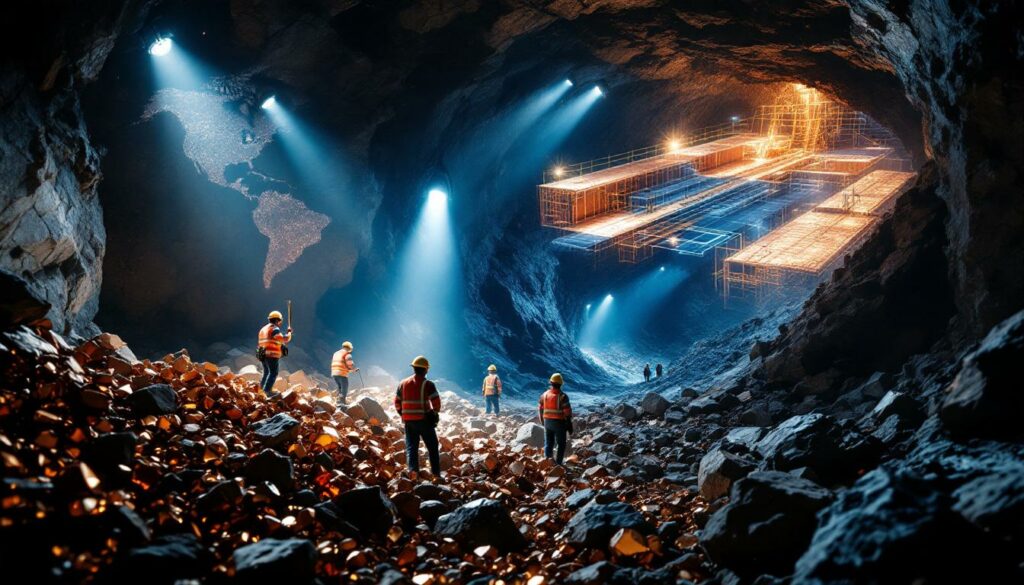El Teniente Mine's Path to Recovery: Navigating Challenges After the Earthquake
On August 2, 2025, Chile's mining industry was shaken by tragedy when an earthquake triggered a catastrophic collapse at the El Teniente copper mine. Six workers lost their lives in what became one of the most significant mining disasters in recent Chilean history. The event prompted an immediate shutdown of operations at this critical facility, sending ripples through global copper markets and challenging Codelco's production capabilities.
As Codelco seeks approval to reopen El Teniente mine after earthquake-induced collapse, the mining giant faces a complex landscape of safety concerns, regulatory requirements, and economic pressures. The reopening process highlights broader questions about mining safety in seismically active regions and the delicate balance between productivity and worker protection.
The Devastating Impact at El Teniente
The Earthquake and Its Immediate Aftermath
El Teniente, recognized as one of the world's largest underground copper mines, fell victim to nature's force when seismic activity triggered a devastating structural collapse in early August 2025. The disaster claimed six miners' lives and left the Chilean mining community in mourning. Located in the Andes Mountains about 80 kilometers south of Santiago, this century-old mining complex is a cornerstone of Chile's copper industry, having produced over 300,000 tonnes of copper in 2024 alone.
"This represents one of the most significant mining safety incidents in Chile's recent history, particularly impacting a facility of El Teniente's scale and importance." – Mining Technology, August 7, 2025
The immediate response prioritized worker safety, with Codelco implementing emergency protocols to evacuate remaining personnel and initiate search and rescue operations. Chile's mining regulator, Sernageomin, quickly stepped in to formalize the suspension of all mining activities at the site, effectively halting operations across the entire complex.
The Scale of Operational Disruption
The suspension extends beyond the immediate mining areas affected by the collapse. El Teniente's entire operational ecosystem—including ore extraction, transportation systems, processing facilities, and support infrastructure—has been forced into standby mode. This complete shutdown highlights the integrated nature of modern mining operations, where a failure in one section effectively paralyzes the entire production chain.
The mine's underground network, spanning hundreds of kilometers of tunnels and reaching depths of over 2,400 meters, requires comprehensive safety assessments before any resumption can be considered. Engineers must evaluate structural integrity throughout the complex, identify vulnerable areas, and implement reinforcement measures where necessary.
El Teniente's Critical Role in Codelco's Portfolio
Economic Significance and Production Value
El Teniente isn't just another mine in Codelco's portfolio—it's a foundational asset producing approximately 300,000 tonnes of copper annually, representing roughly 20% of the company's total copper output. This production capacity translates to billions in annual revenue and contributes significantly to Chile's position as the world's leading copper producer.
The extended shutdown threatens Codelco's annual production targets at a time when the state-owned company is already navigating challenging financial waters. With development projects requiring substantial capital investment, the revenue loss from El Teniente creates additional pressure on the company's financial planning and project timelines.
Ripple Effects Throughout the Supply Chain
The suspension has triggered a cascade of operational adjustments throughout the copper supply chain:
- Processing plants dependent on El Teniente's ore have shifted to maintenance operations
- Transportation systems servicing the mine stand idle
- Smelting facilities have implemented modified operating schedules to maintain equipment readiness
- Downstream metal fabricators may face supply constraints if the shutdown extends
Perhaps most notably affected is Minera Valle Central (MVC), a subsidiary of Amerigo Resources that has processed tailings from El Teniente since 1992. While MVC continues processing historic tailings, the company estimates a daily production loss of approximately 100,000 pounds of copper due to the suspension of fresh tailings processing.
This supply chain disruption illustrates the interconnected nature of modern mining industry evolution, where a single failure point can impact numerous connected businesses and thousands of workers.
Navigating Chile's Mining Regulatory Framework
Sernageomin's Four-Report Requirement
Chile's mining regulatory framework places strict requirements on mine operators following major safety incidents. In El Teniente's case, Sernageomin has mandated that Codelco submit four comprehensive reports before resumption can be considered:
- Root Cause Analysis: A detailed investigation identifying the factors that contributed to the collapse, including seismic data, structural assessments, and timeline of events
- Structural Integrity Evaluation: Comprehensive engineering assessments of remaining mine sections to determine stability and safety status
- Safety Protocol Revisions: Updated operational safety procedures specifically addressing seismic risks and emergency response
- Remediation Action Plan: Detailed plans for addressing vulnerabilities and implementing structural reinforcements
According to available information, Codelco has already fulfilled three of these requirements, submitting reports to both Sernageomin and the Chilean labor inspection office. The company's progress suggests a systematic approach to addressing regulatory concerns, though the timeline for potential reopening remains contingent on regulatory approval.
Chile's Evolving Mining Safety Standards
The El Teniente incident comes at a time when Chile has been strengthening its mining safety regulatory framework. The country's rich mining history has been punctuated by disasters that have progressively led to more stringent safety requirements.
The regulatory process following the El Teniente collapse exemplifies Chile's modern approach to mining safety—balancing the economic importance of mineral extraction with the paramount concern for worker protection. This balanced approach recognizes both the necessity of mining for Chile's economy and the obligation to ensure operations meet world-class safety standards.
Maintaining Operational Readiness During Suspension
Strategic Maintenance of Processing Infrastructure
Despite the mining suspension, Codelco has implemented a strategic maintenance program to preserve operational readiness at El Teniente's processing facilities. This program includes:
- Regular cleaning operations at processing plants to prevent equipment deterioration
- Bi-hourly operation of the smelter's anode furnaces to maintain functional capability
- Rotation of equipment usage to ensure even wear and system integrity
- Preventive maintenance on critical components that would otherwise deteriorate during extended shutdown
These activities reflect a well-established mining industry practice of preserving complex processing equipment during unplanned shutdowns. The approach minimizes restart delays by preventing equipment degradation that would otherwise require extended repair periods before resumption.
Transitioning to Maintenance Mode
A source close to Codelco's operations indicated that the transition to "maintenance mode" was necessitated by the absence of copper for processing. This operational pivot demonstrates the adaptability required in modern mining operations when facing unexpected disruptions.
The maintenance mode transition involved:
- Sequenced shutdown of production processes to minimize equipment stress
- Reallocation of personnel from production to maintenance roles
- Implementation of specialized preservation protocols for sensitive equipment
- Establishment of minimal operational parameters to maintain system functionality
This operational flexibility represents a critical capability for mining companies operating in seismically active regions, where unexpected disruptions require rapid adaptation to preserve both equipment value and restart capability.
Broader Economic and Industry Impact
Partners and Suppliers in the Balance
The El Teniente suspension extends far beyond Codelco's direct operations. Numerous partner companies, suppliers, and service providers are experiencing significant disruption:
-
Minera Valle Central (MVC): This Amerigo Resources subsidiary has processed tailings from El Teniente since 1992. While MVC continues processing historic tailings, the company estimates daily production losses of approximately 100,000 pounds of copper due to the suspension of fresh tailings processing.
-
Transportation and Logistics Providers: Companies responsible for moving copper concentrate and supplies to and from El Teniente have seen significant volume reductions.
-
Maintenance and Support Services: Contractors providing specialized maintenance, catering, and support services face reduced demand during the suspension.
-
Equipment Suppliers: Companies providing replacement parts and consumables for mining operations are experiencing reduced orders.
These cascading impacts highlight the economic ecosystem surrounding major mining operations and the widespread effects when production at cornerstone facilities is disrupted.
Production Losses and Financial Implications
The financial impact of the suspension grows with each passing day. Based on El Teniente's production capacity and current copper price insights, the direct revenue impact likely exceeds $2 million daily. This figure excludes the considerable costs associated with maintaining equipment during shutdown and the eventual restart expenses.
For Codelco, these losses come at a particularly challenging time. The state-owned company faces substantial capital requirements for ongoing development projects, including the critical El Teniente New Mine Level project, which aims to extend the mine's productive life by decades.
The full financial impact will ultimately depend on several factors:
- Duration of the suspension
- Extent of required remediation measures
- Phasing of production resumption
- Copper price movements during the affected period
- Insurance coverage for business interruption
Codelco's Strategic Reopening Approach
The Partial Resumption Strategy
Rather than pursuing an all-or-nothing approach to reopening, Codelco has requested permission to restart operations in specific sections of the El Teniente complex. This phased strategy reflects a pragmatic approach that acknowledges varying risk profiles across different mine sections.
The partial reopening request likely focuses on:
- Areas farthest from the collapse zone
- Sections with newest infrastructure and reinforcement
- Zones with most favorable geological stability profiles
- Locations with multiple evacuation routes and safety features
This incremental approach allows for a controlled restoration of some production capacity while maintaining heightened safety standards in the most vulnerable areas. It also enables Codelco to generate some revenue while continuing remediation efforts in affected sections.
Balancing Safety and Production Imperatives
The partial reopening strategy exemplifies the constant balance mining companies must maintain between safety imperatives and production pressures. For Codelco, this balance is particularly delicate given:
- The company's role as a state-owned enterprise with public accountability
- The economic importance of copper production to Chile's national economy
- The scrutiny following worker fatalities
- The need to demonstrate improved safety protocols before full resumption
The strategy demonstrates an evolution in mining safety approaches, moving away from binary suspension/operation decisions toward more nuanced, risk-based operational models. This approach acknowledges that large mining complexes contain zones with substantially different risk profiles that can be managed accordingly.
The Road to Recovery: Reopening Process and Timeline
Key Milestones for Resuming Operations
While specific reopening dates remain uncertain, the path forward will likely follow several critical milestones:
-
Completion of Regulatory Requirements: Submission and approval of the fourth required report to Sernageomin
-
Remediation Implementation: Execution of critical safety enhancements and structural reinforcements identified in assessment reports
-
Phased Operational Testing: Controlled testing of systems and equipment under enhanced monitoring
-
Limited Production Resumption: Initial production in approved sections with heightened safety protocols
-
Graduated Expansion: Progressive expansion of operations to additional mine sections as safety assessments permit
-
Full Operational Recovery: Complete restoration of production capacity with permanently enhanced safety measures
This milestone-based approach allows for careful evaluation at each stage, with safety verification preceding production expansion. The timeline for this process could range from weeks to months, depending on the extent of required remediation and regulatory approval timelines.
Enhanced Safety Protocols and Monitoring
Any reopening will incorporate substantially enhanced safety measures, likely including:
- Advanced Seismic Monitoring: Expanded network of seismic sensors with real-time alert capabilities
- Reinforced Support Systems: Additional ground support in vulnerable areas
- Evacuation Protocol Enhancements: Revised emergency procedures with reduced response times
- Communication Improvements: Redundant communication systems for underground workers
- Training Intensification: Additional safety training focusing on seismic event response
- Monitoring Command Center: Centralized facility for continuous assessment of mine conditions
These enhancements represent not only regulatory requirements but essential measures to protect workers in a region where seismic activity remains an ongoing risk factor for underground operations.
Lessons for Mining Safety in Seismic Regions
Engineering Challenges in Seismically Active Zones
The El Teniente incident highlights the unique challenges of underground mining in seismically active regions. Mining operations in such environments must contend with:
- Dynamic Ground Pressures: Seismic activity can drastically and suddenly alter stress distributions in underground workings
- Structural Vulnerabilities: Mining-induced stress combined with natural fault lines creates complex stability challenges
- Evacuation Complications: Underground environments limit evacuation options during seismic events
- Monitoring Limitations: Even advanced monitoring systems provide limited warning for certain types of seismic activity
These challenges require specialized engineering approaches that go beyond standard mining practices. Mining companies operating in the "Ring of Fire" and other seismically active regions must incorporate seismic risk into every aspect of mine planning and operation.
Industry-Wide Implications and Best Practices
The El Teniente incident may accelerate the adoption of enhanced safety practices across the mining industry, particularly in seismically active regions. Emerging best practices likely to gain traction include:
- Real-time Microseismic Monitoring: Continuous monitoring of micro-movements to detect precursor activities
- Dynamic Support Systems: Ground support designed to absorb energy rather than resist movement
- Predictive Analytics: AI-powered systems to identify potential risk patterns before major events
- Refuge Chamber Enhancements: Improved emergency shelters with extended life support capabilities
- Robotics and Automation: Increased use of remote-operated equipment in highest-risk areas
- Regulatory Harmonization: Standardized approaches to seismic risk management across mining jurisdictions
These adaptations reflect the mining industry's ongoing evolution toward safer practices in challenging geological environments. The lessons from El Teniente will likely influence mining permitting process standards not only in Chile but in other copper-producing regions with similar geological characteristics.
Key Considerations for El Teniente's Future
Short-Term Recovery Priorities
As Codelco seeks approval to reopen El Teniente mine after earthquake-induced collapse, several immediate priorities will guide decision-making:
- Worker Safety Assurance: Implementing enhanced protection measures and monitoring systems
- Production Stabilization: Establishing sustainable production levels under new safety protocols
- Confidence Restoration: Rebuilding trust among workers, regulators, and the Chilean public
- Supply Chain Reactivation: Coordinating with partners to restart the full production ecosystem
The company's ability to address these priorities will determine not only the speed of recovery but also the sustainability of operations under enhanced safety requirements.
Long-Term Implications for El Teniente Development
Beyond immediate recovery, the incident raises questions about El Teniente's long-term development plans. The mine's New Mine Level project, designed to access deeper ore bodies and extend the operation's life, must now incorporate additional safety considerations.
Key questions for the mine's future development include:
- How will design parameters change to address seismic risks?
- What additional safety margins will be incorporated into support systems?
- How will evacuation systems evolve to address deeper mining areas?
- What monitoring technologies will be deployed in new development areas?
The answers to these questions will shape not only El Teniente's future but potentially influence underground mining approaches worldwide, particularly in seismically active regions. Furthermore, these developments will likely impact the global copper supply forecast as mining companies implement new mine reclamation innovations and safety protocols.
Disclaimer: This article contains analysis of ongoing developments and potential future outcomes. The actual reopening timeline, regulatory decisions, and operational details may differ from those discussed. Mining operations involve inherent risks, and companies must continuously adapt safety protocols to address emerging challenges.
Looking for the Next Major Mining Discovery?
Discovery Alert's proprietary Discovery IQ model delivers instant notifications when significant ASX mineral discoveries are announced, giving subscribers a crucial advantage in identifying high-potential investment opportunities before they reach mainstream attention. Visit Discovery Alert's dedicated discoveries page to understand how major mineral discoveries have historically generated exceptional returns for early investors.




